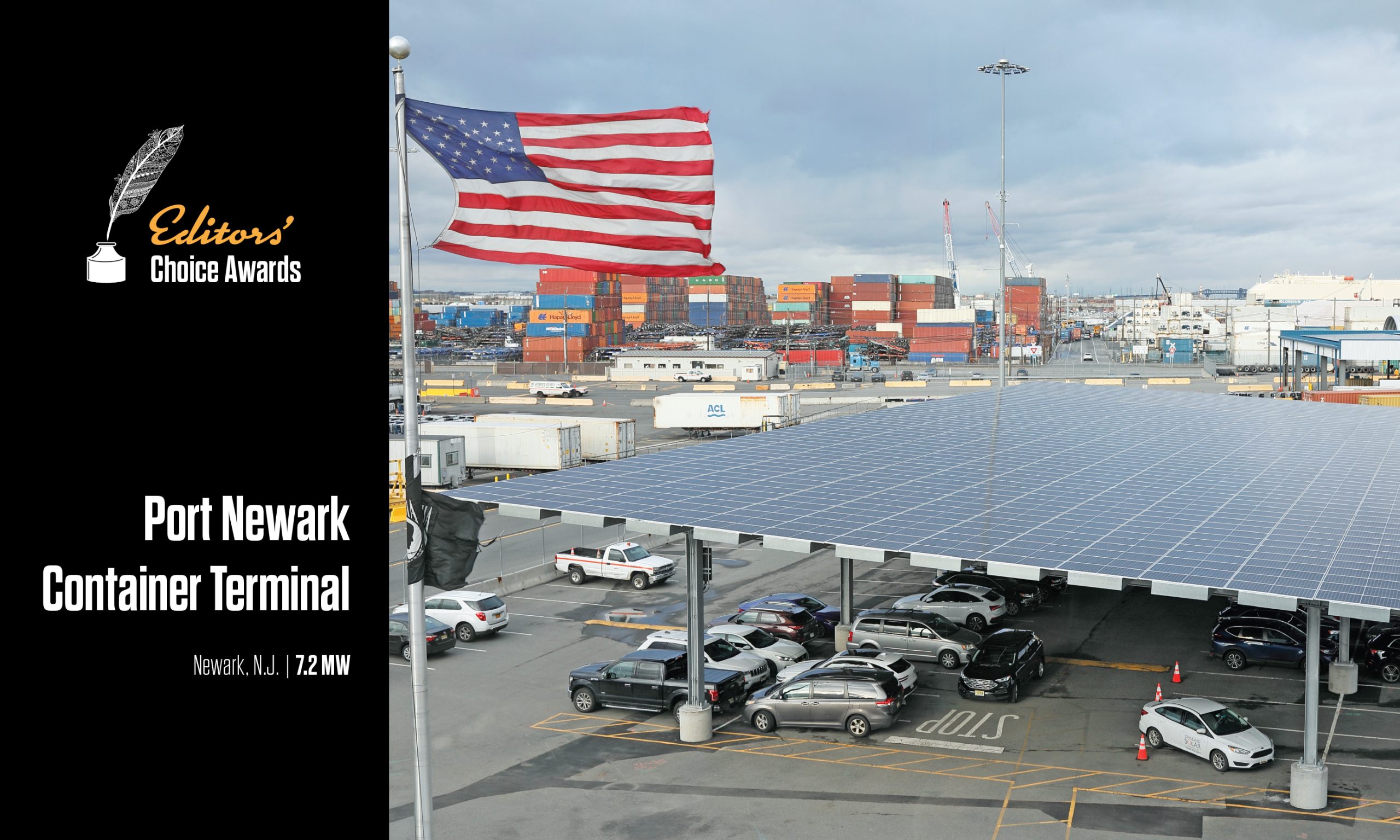
Editors' Choice Awards
Not everyone who submits a nomination for the Project of the Year Awards gets recognized. This year we saw close to 40 entries, among which we selected 24 across six categories for the online vote, leading to the six winners we just featured.
So no, not everyone gets a trophy … but we do think a few more projects deserve trophies. We’re a staff of late-stage Gen X-ers and Millennials after all.
Welcome to the Editors’ Choice portion of Projects of the Year. We are not solar pros out in the field, but we do write about dozens of solar projects every week at solarbuildermag.com. We have a feel for what’s fairly routine and what’s unique, impactful or notable. The following projects were nominated for our Project of the Year Awards, didn’t win the reader vote, but caught our collective editorial eye — for reasons ranging from impressive installation work and use of public sites to utility and grid-scale innovations that could be harbingers of big change down the road.

University of Kansas Studio 804
Lawrence, Kan. | 6.4 kW
Developer: University of Kansas School of Architecture & Design | EPC/Installer: Studio 804 | Modules: Qcells | Inverters: Enphase | Mounting/Racking: S-5! PVKIT
Students from the University of Kansas installed a 6.4 kW rooftop solar system on a single-family house in a historic sector of Lawrence, Kansas. Completed in May, the system is expected to offset approximately 85% of the homeowner’s energy consumption.
Studio 804 is a hands-on learning program at the University of Kansas for graduate students in their final year of studies seeking a Master of Architecture degree at the university’s School of Architecture & Design. Founded in 1995 by Professor Dan Rockhill, each year students design, procure and execute the completion of a building of great technical sophistication in just nine months.
The 432 Indiana Street House is located in the historic Pinkney Neighborhood, one of the oldest in the city of Lawrence. The 1,800-square-foot home and adjacent 500-sq-ft accessory dwelling unit are (wall-) clad in glossy black fiber cement panels and topped with a 24-gauge matte black standing seam metal roof.
Why’d we pick it? In 2023, all new buildings should be designed with PV in mind. So, embedding solar PV into the curriculum of an architectural design program (not based in California), is a crucial step forward for the solar industry. Adding the hands-on component is especially cool. Need to build that solar workforce ASAP!

Houston Solar Farm
Houston, Alaska | 8.5 MW
Developer/EPC/Installer: Renewable IPP | Modules: Risen Energy | Inverters: SMA America | Mounting/Racking: APA Solar Racking
The 8.5 MW, 45-acre Houston Solar Farm was developed by Renewable IPP (RIPP) and powers approximately 1,400 homes in Houston, Alaska. CleanCapital financed the project construction and serves as the long-term owner-operator. The local utility, Matanuska Electric Association Inc. (MEA), purchases the project’s generated energy.
Given Alaska’s climate conditions and remote location, securing renewable project financing was a challenge. Locating trained solar construction contractors also proved to be difficult given the nascent solar energy market. Additionally, preserving the native landscape was an important consideration and a key area of focus for all Alaskans.
Completed in August, the solar farm was built on “raw” land, lessening environmental impact by preserving the native vegetation and soil. For example, to enable the growth of cranberry and blueberry bushes, a mulching technique was implemented. The project was designed to enable snow shedding and snow blowing between panel rows as well.
Why’d we pick it? The diversity of the workforce. As mentioned, solar-trained workers were not readily available for this project. Not only did Renewable IPP take on the task of sourcing and training the construction team from the local community — but women compromised 30% of the team! That is not a typical stat, and it’s worth an extra blurb in the spotlight.

Port Newark Container Terminal
Newark, N.J. | 7.2 MW
Developer/EPC/Installer: Standard Solar | Modules: Talesun Solar | Inverters: CPS America | Mounting/Racking: ParaSol (carport)
This 7.2 MW rooftop and carport solar system for Port Newark Container Terminal (PNCT) in Newark, N.J., is a joint venture involving Ports America, Terminal Investment Limited (TIL) and Standard Solar. The project consists of two rooftop and five carport solar arrays, including a large-scale 3.8 MW canopy spanning multiple truck lanes at the 320-acre facility.
Situated within one of America’s most active ports, the project’s complexity arose from the need to seamlessly integrate with the constant flow of hundreds of vehicles and the daily operations of the port. Designed to produce 8,476 MWh hours annually, the system will cover approximately 50% of PNCT’s annual electrical demand, representing a significant reduction in demand for the Newark area electrical grid. The project is set to be fully completed by the end of 2023.
Why’d we pick it? Construction ingenuity. The Standard Solar team encountered soft soils and a high water table that required a complicated carport foundation solution: four timber piles driven down 30 ft, then tied together with rebar and capped with an 8-by-8 ft concrete foundation. It was also necessary to build large elevated platforms to support all electrical equipment 6 ft above grade to limit exposure to flood waters.

Wishcamper Hampden
Hampden, Maine | 6.77 MW
Developer/EPC: ReVision Energy | Installers: ReVision Energy, Terrasmart | Modules: Qcells | Inverters: CPS America | Mounting/Racking: Terrasmart
Completed in January, the Wishcamper Hampden project — built in an abandoned gravel pit in Hampden, Maine — will offset energy usage for multiple Maine municipalities and school districts, reducing their utility bills and saving taxpayers money. Communities benefiting from this project include the College of the Atlantic, the Deer Isle/Stonington School District, the Town of Blue Hill, and the Bangor Water District.
Developer and EPC ReVision Energy performed thorough site work well ahead of kicking off construction for the Wishcamper Companies Inc., the investor and owner of this 6.77 MW project.
Why’d we pick it? Converting an abandoned gravel pit into a solar farm is not simple. The 25-acre site contained huge piles of rocks, mountains of soil, sheer cliffs, extensive weeds and shrubbery up to 2.5 ft tall. ReVision and the team at Terrasmart cleared roughly three acres of land and graded most of the site. Adding to its manpower, ReVision deployed multiple excavators, bulldozers, and even a forestry mulcher on the entire site to grind up the copious stumps, roots and sticks before breaking down any remaining organic material with a harley rake.

North Dade Regional Library
Miami-Dade, Fla. | 475 kW
Developer: Miami-Dade County | EPC/Installer: Advanced Green Technologies | Modules: Canadian Solar | Inverters: CPS America | Mounting/Racking: DCE Solar
Advanced Green Technologies and Advance Roofing completed the first large-scale county-owned solar roof in Miami-Dade, Fla., at the North Dade Regional Library in Miami Gardens. The 475 kW rooftop solar installation started in August 2022 and was completed in April 2023.
The solar array comprises 1,093 modules, 41 strings, six 60 kWac inverters, and a Veris E51C2A meter for monitoring. The system will provide annual energy production of 709.9 MWh and is expected to offset the building’s energy usage by 85%. This project was developed under a DMS contract and energy service agreement.
The eight-person crew installed the solar array using a north/south racking system, front and rear beams made of galvanized steel resting on rubber pads attached to the concrete deck and flashed into the roof system. The bus duct presented a challenge for the team as interconnection required coordination in planning and execution with the library, vendor, Authority Having Jurisdiction (AHJ), and utility Florida Power & Light.
Why’d we pick it? We have a soft spot for municipal / public solar PV projects, and we always give that extra credit nod for PV projects of this size getting done in Miami-Dade County. Love the fact that the county itself initiated it — and it is just the first of three pilot projects being implemented in Miami-Dade County in 2023. The South Dade Regional Library and the MetroWest Detention Center are the other two projects in the pipeline and will be completed later this year.



